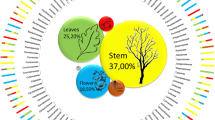Abstract
Natural colorants or dyestuffs are an essential faction of non-timber forest products that are widely used for coloring purposes in various industries. Of course, now-a-days synthetic dyes are used as a coloring agent but due to their various environmental, social and health problems, people are shifting from synthetic to natural coloring agents. Present paper provides a comprehensive review on dye yielding plants of Northwestern and Western Himalaya. A total of 87 dye producing plants belonging to 45 families and 74 genera including 38 herbs, 19 shrubs, 25 trees and 5 climbers, have been documented. Out of these, 26 species are well known as dye producing plants and are exploited commercially. The remaining 61 species are traditionally used for coloring purposes on a very small scale and a very little information is available as to their coloring properties. The study revealed that there is an urgent need to develop a pertinent policy and action plan for the optimum utilization of the available dyestuff.





Similar content being viewed by others
References
Alawa, K. S., Ray, S., & Dubey, A. (2013). Dye yielding plants used by tribals of Dhar district, Madhya Pradesh India. Science Research Reporter, 3(1), 30–32.
Anonymous. (1883–1970). Index kewenasis plantarum phanerogamarum (Vol I–II, pp. 1883–1885) and 15 Suppl. (1886–1970). Oxford: Clarendon Press.
Bhuyan, R. (2003). Extraction of natural colorants from roots of Moringa angustifolia Roxb. their identification and studies of dyeing characteristics of wool. Indian Chemical Technology, 10, 131–136.
Chandramouli, K. V. (1995). Sources of Natural Dyes in India A Compendium with Regional Names (p. 116). PPST Foundation.
Das, P. K., Mondal, A. K., & Parui, S. M. (2011). Antibacterial activity of some selected dye yielding plants in Eastern India. African Journal of Plant Sciences, 5(9), 510–520.
Dhar, U., Manjkhola, S., Joshi, M., Bhatt, I. D., Bisht, A. K., & Joshi, M. (2002). Current status and future strategy for development of medicinal plants sector in Uttaranchal India. Current Science, 83(8), 956–964.
Ganie, S. A., Ara, S., & Mehmood, M. A. (2017). Extraction, application, chemical characterization of natural dye for Calendula officinalis L. International Journal of Advanced Research in Science and Engineering, 6(11), 1357–1364.
Gaur, R. D. (2008). Traditional dye yielding plants of Uttarakhand India. Natural Product Radiance, 7(2), 154–165.
Ghosh, D., & Das, A. P. (2007). Use of dye yielding plants by the tribal tea garden workers in Terai and hills of Darjiling. Pleione, 1, 19–22.
Gokhale, S. B., Tatiya, A. U., Bakliwal, S. R., & Fursule, R. A. (2004). Natural dye yielding plants of India. Natural Product Radiance, 3(4), 228–234.
Grover, N., & Patni, V. (2011). Extraction and application of natural dye preparations from the floral parts of Woodfordia fruticosa (Linn.) Kurz. Indian Journal of Natural Products and Resources, 2(4), 403–408.
Haji, A. (2010). Functional dyeing of wool with natural dye extracted from Berberis vulgaris wood and Rumex hymenosepolus root as biomordant. Iranian Journal of Chemistry and Chemical Engineering, 29(3), 55–60.
Kar, A., & Borthakur, S. K. (2008). Dye yielding plants of Assam for dyeing handloom textile products. Indian Journal of Traditional Knowledge, 7(1), 166–171.
Kumari, P., Samant, S. S., Puri, S., Singh, A., & Rathore, S. (2019). Diversity, indigenous uses and traditional practices of dye yielding plants in Central Himachal Pradesh, Northwestern Himalaya. Indian Journal of Traditional Knowledge, 18(3), 560–564.
Mehta, P., Chandrasekar, K., Bhatt, D., Tewari, A., Bisht, K., Upadhyay, S., Negi, V. S., & Soragi, B. (2020). Conservation and priortization of threatened plants in Indian Himalayan Region. Biodiversity and Conservation, 29(6), 1723–1745.
Rajesh, Y., Nita, Y., & Dhar, K. M. (2014). A review: Dye yielding sources and their importance. International Journal of Pharmacognosy and Phytochemical Research, 6(2), 241–248.
Rakhecha, P. R., Kulkarni, A. K., Mandal, B. N., & Dhar, O. N. (1983). Winter and spring precipitation over the northwestern Himalaya. In Proceedings of the first national symposium on seasonal snow cover (pp. 175–181). New Delhi.
Samant, S. S., Dhar, U., & Palni, L. M. S. (1998). Medicinal plants of Indian Himalaya. Diversity Distribution PotentialValues.
Samant, S. S. (2015). Assessment, valuation and conservation prioritization of floristic diversity in Trans Northwestern and Western Himalaya. Kumaun University.
Saxena, S., & Raja, A. S. M. (2014). Natural Dyes: Sources Chemistry Application and Sustainability Issues. Central Institute for Research on Cotton Technology.
Sharda, L. N., & Rastogi, D. (2013). Unexplored treasure of Garhwal Himalaya: Dye yielding plants for sustainable dyeing. Journal of Academia and Industrial Research, 2(3), 155–159.
Siva, R. (2007). Status of natural dyes and dye yielding plants in India. Current Science, 92(7), 916–925.
Vankar, P. S. (2016). Handbook on natural dyes for industrial applications. National Institute of Industrial Research.
Acknowledgements
The authors are thankful to Head, Department of Botany, BGSB University, Rajouri, Jammu and Kashmir, Union Territory, India for providing necessary facilities and encouragement.
Author information
Authors and Affiliations
Corresponding author
Ethics declarations
Conflict of Interest
The authors declare that they have no conflict of interest.
Additional information
Publisher's Note
Springer Nature remains neutral with regard to jurisdictional claims in published maps and institutional affiliations.
Rights and permissions
About this article
Cite this article
Wani, Z.A., Samant, S.S. & Pant, S. Diversity, utilization pattern and representativeness of dye yielding plants in North Western and Western Himalaya, India: an untapped source for Bioprospection. Environ Dev Sustain 24, 4493–4510 (2022). https://doi.org/10.1007/s10668-021-01664-x
Received:
Accepted:
Published:
Issue Date:
DOI: https://doi.org/10.1007/s10668-021-01664-x




